Vintage Treasures: Modern Classics of Science Fiction edited by Gardner Dozois
Modern Classics of Science Fiction (St. Martin’s Press, 1992). Jacket illustration courtesy of NASA
Back in October I wrote about Gardner Dozois’ 1994 anthology Modern Classic Short Novels of Science Fiction, saying it was one of my favorite fall reads. I noted at the time that it was part of a trilogy of books Gardner did for St. Martin’s that also included Modern Classics of Fantasy (1997), which I called “a book that makes you yearn to be stranded on a desert island.” But I’ve never discussed its sister volume, and first in the sequence, Modern Classics of Science Fiction (1992), and so today I thought I’d correct that egregious oversight.
Modern Classics of Science Fiction is a fabulous collection. Like the books that followed, it’s an eclectic and personal volume, filled not with the most famous and acclaimed short science fiction, but instead Gardner’s highly personal selection of some of the best SF of the 20th Century. It includes 26 stories published between 1956 and 1989, by Theodore Sturgeon, Richard McKenna, Jack Vance, Edgar Pangborn, Roger Zelazny, R. A. Lafferty, Samuel R. Delany, Brian W. Aldiss, Gene Wolfe, James Tiptree, Jr., Ursula K. Le Guin, Howard Waldrop, Lucius Shepard, Michael Swanwick, and many more.
I find it refreshing that Dozois didn’t feel compelled to include many of SF’s most famous authors, or the most famous stories from his contributors, and that gives him room to pack in a wide range of neglected gems. So no Heinlein, no Asimov, no Poul Anderson, Arthur C. Clarke, or Harlan Ellison. No Fred Pohl or Philip K. Dick, and no Ray Bradbury or Anne McCaffrey. No Larry Niven, J.G. Ballard, or Alfred Bester.
What have we got instead? A great many stories most of you have never heard of.
They include:
- Richard McKenna’s “Casey Agonistes,” in which a patient in a tuberculous ward sweeps his fellow patients into a strangely joyous shared hallucination as they wait for death;
- Edgar Pangborn’s “The Golden Horn,” later expanded into his classic novel Davy;
- Keith Roberts’ Pavane tale “The Lady Margaret;”
- Roger Zelazny’s Hugo and Nebula award nominee “This Moment of the Storm;”
- Brian Aldiss’ often forgotten tale of a distant future which humans have radically changed, taking the shape of trees, apes, and stranger forms as they seek for the meaning of life;
- Joanna Russ’s story of bizarre far-future families, “Nobody’s Home;”
- Jack Dann’s Nebula nominee “Going Under;” Connie Willis’s World Fantasy Award nominee for Best Novella “Chance,”
- Michael Swanwick’s Sturgeon Award winner “The Edge of the World;”
- and Bruce Sterling’s strange alternate-history love story of counterculture icons Lester Bangs and Dori Seda, “Dori Bangs.”
Inside flap for Modern Classics of Science Fiction
To go along with the personal collections, Gardner included a lengthy, chatty, and very personal introduction for each story. Here’s the first paragraph of his three-page intro to Delany’s “Driftglass.”
I picked up Samuel R. Delany’s first published novel, The Jewels of Aptor, in 1962, as soon as it hit the newsstands (I even remember which newsstand, one on the platform in a subway station under what had once been Scolley Square, in Boston; memory is a funny thing), and, although it was packaged no differently that dozens of other Ace Doubles I’d read with only low-key interest in other years — same garish and ugly pulp cover, same overheated pulp blurbs — I felt a thrill of excitement with the very fist page, an almost physical tingle, as though a small electric current was passing through the paper, and I knew at once that I was in contact with a very uncommon talent indeed.
Dozois’ intros had their own sorcery, I think. He certainly sharpened your interest in the story you were about to read, of course. But the way he described science fiction, capable of surprising you with transporting wonders found sandwiched between tattered magazines at a subway newsstand, made it sound almost infinitely rich. A treasure hidden between the cracks of the mundane world, visible only to those who know where to look, like a secret station to Hogwarts School of Witchcraft and Wizardry at Platform 9 ¾. Admit it, now you want to read The Jewels of Aptor.
Back cover of Modern Classics of Science Fiction
Here’s the complete Table of Contents.
Preface by Gardner Dozois
“The Country of the Kind” by Damon Knight (The Magazine of Fantasy and Science Fiction, February 1956)
“Aristotle and the Gun” L. Sprague de Camp (Astounding Science Fiction, February 1958)
“The Other Celia” by Theodore Sturgeon (Galaxy Science Fiction, March 1957)
“Casey Agonistes” by Richard McKenna (The Magazine of Fantasy and Science Fiction, September 1958)
“Mother Hitton’s Littul Kittons” by Cordwainer Smith (Galaxy Magazine, June 1961)
“The Moon Moth” by Jack Vance (Galaxy Magazine, August 1961)
“The Golden Horn” by Edgar Pangborn (The Magazine of Fantasy and Science Fiction, February 1962)
“The Lady Margaret” by Keith Roberts (Impulse, April 1966)
“This Moment of the Storm” by Roger Zelazny (The Magazine of Fantasy and Science Fiction, June 1966) — Hugo and Nebula nominee
“Narrow Valley” by R. A. Lafferty (The Magazine of Fantasy and Science Fiction, September 1966)
“Driftglass” by Samuel R. Delany (If, June 1967) — Nebula nominee
“The Worm That Flies” by Brian W. Aldiss (The Farthest Reaches, 1968)
“The Fifth Head of Cerberus” by Gene Wolfe (Orbit 10, 1972) — Nebula, Hugo, and Locus Award nominee
“Nobody’s Home” by Joanna Russ (New Dimensions 2, 1972)
“Her Smoke Rose Up Forever” by James Tiptree, Jr. (Final Stage: The Ultimate Science Fiction Anthology, 1974)
“The Barrow” by Ursula K. Le Guin (Orsinian Tales, 1976)
“Particle Theory” by Edward Bryant (Analog Science Fiction/Science Fact, February 1977) – Nebula and Locus nominee
“The Ugly Chickens” by Howard Waldrop (Universe 10, 1980) — Hugo nominee, Nebula and World Fantasy Award winner
“Going Under” by Jack Dann (Omni, September 1981) — Nebula Award nominee
“Salvador” by Lucius Shepard (The Magazine of Fantasy & Science Fiction, April 1984) — Hugo and Nebula nominee, Locus Award winner
“Pretty Boy Crossover” by Pat Cadigan (Isaac Asimov’s Science Fiction Magazine, January 1986) — Nebula nominee
“The Pure Product” by John Kessel (Isaac Asimov’s Science Fiction Magazine, March 1986)
“The Winter Market” by William Gibson (Interzone, #15 Spring 1986) — Nebula, Hugo, Locus nominee
“Chance” by Connie Willis (Isaac Asimov’s Science Fiction Magazine, May 1986) — World Fantasy nominee
“The Edge of the World” by Michael Swanwick (Full Spectrum 2, 1989) — World Fantasy, Hugo, Locus nominee, Sturgeon Award winner
“Dori Bangs” by Bruce Sterling (Isaac Asimov’s Science Fiction Magazine, September 1989) — Nebula, Hugo, Locus nominee
Afterword by Gardner Dozois
The Legend Book of Science Fiction (Legend, 1991)
Modern Classics of Fantasy is part of a series of anthologies edited by Gardner for St. Martin’s Press that includes:
Modern Classics of Science Fiction (1992)
Modern Classic Short Novels of Science Fiction (1994)
Modern Classics of Fantasy (1997)
Modern Classics of Science Fiction was ordinally published in the UK in 1991 as The Legend Book of Science Fiction, and reprinted the following year by St. Martin’s Press under the revised title. It has not been reprinted since, and there is no digital edition. The St. Martin’s edition is 672 pages, priced at $27.50 in hardcover and $15.95 in trade paperback. The cover is a NASA image of Saturn.
See all our recent Vintage Treasures here.
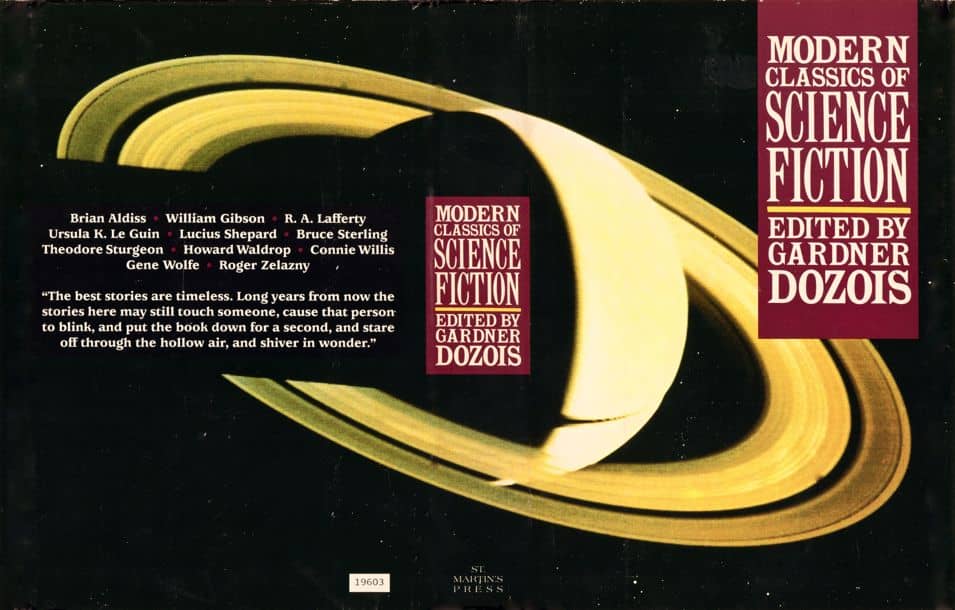
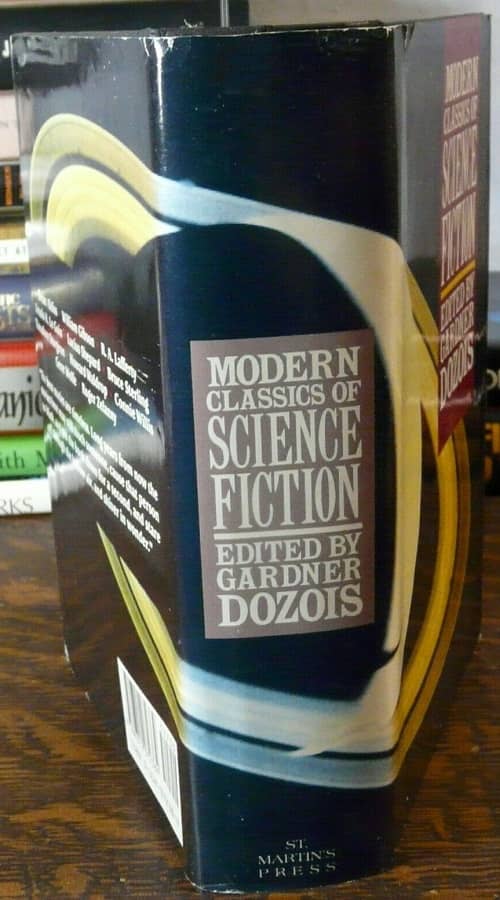
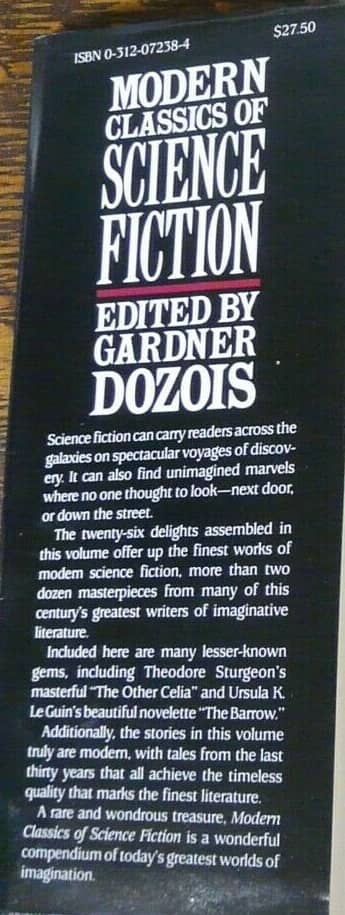
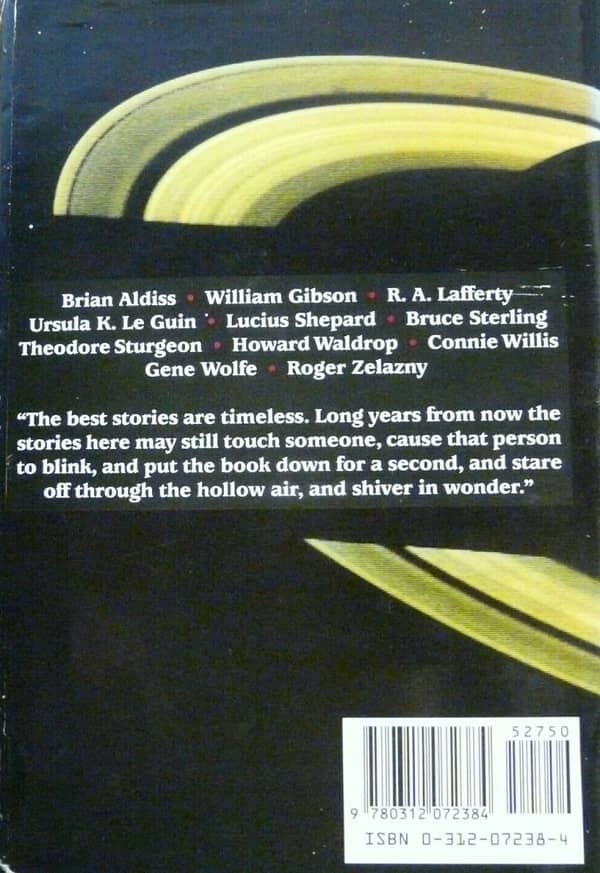
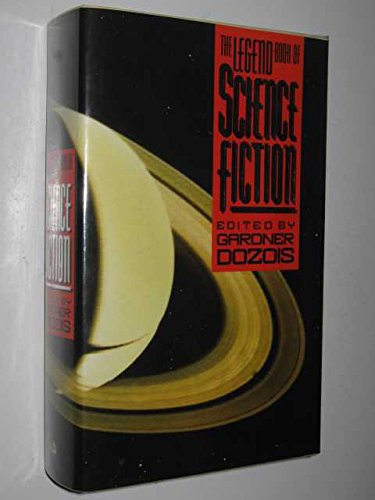
I am impressed at how “modern” the selections are, with 6 of them being 5 years or less from first publication. And quite eclectic in his definition of science fiction, as several of them are only lightly speculative (like Le Guin’s Orsinian tale, “The Barrow”, or Sterling’s alt-history of rock criticism, “Dori Bangs”). I can recall reading most of them, which is some sign of their quality. But I am not sure if I would have had Mr. Dozois’s insight to choose them for a ‘best of’ anthology. That is one reason that he got all those Hugos for Best Editor.
Even Howard Waldrop’s Hugo and Nebula-nominated “The Ugly Chickens” is arguably not SF — though it is a fantastic story. “Dori Bangs” I think is similar. They were written by SF writers and published in SF magazines, and they both rely on a fantastic premise, but they’re not the kind of straight-arrow science fiction I was raised on. But I love them all the more for that!
Same for the LeGuin – The Barrow isn’t really sf, if I remember rightly.
Gardner did his best to include only SF in an SF anthology, but if a story was of exceptional quality, he was prepared to bend the rules a little. For example, Terry Bisson’s famous “Bears Discover Fire” was in The Year’s Best Science Fiction, but it’s also in Modern Classics of Fantasy!
Yeah, but I kina think that story transcends genres. It’s about Bears evolving, right? So it’s obvious SF. But bears! With fire! That’s fantasy for sure.